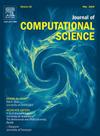Unconditionally stable method for the high-order Allen–Cahn equation
IF 3.7
3区 计算机科学
Q2 COMPUTER SCIENCE, INTERDISCIPLINARY APPLICATIONS
引用次数: 0
Abstract
We propose an unconditionally stable algorithm for the Allen–Cahn (AC) equation that incorporates a high-order free energy. The high-order AC equation improves the preservation of interfacial dynamics and suppresses noise. The proposed method guarantees unconditional stability, which is essential for precise phase transition modeling and preserving detailed characteristics. To effectively solve the governing equation, it is divided into two subproblems, each of which is solved separately. The nonlinear operator is handled using a frozen coefficient method, followed by a closed-form solution. The linear operator is solved by applying the discrete cosine transform. To verify the effectiveness of the proposed algorithm, we carried out various computational simulations in two- and three-dimensional space. The proposed method ensures unconditional stability, and therefore allows stable solutions even with relatively large time steps. Moreover, we investigate the notable characteristics of the high-order AC equation, particularly its enhanced capability to effectively handle phase separation phenomena in the presence of significant noise and complex phase interfaces.
高阶Allen-Cahn方程的无条件稳定方法
我们提出了一个包含高阶自由能的Allen-Cahn方程的无条件稳定算法。高阶交流方程提高了界面动力学的保存,抑制了噪声。该方法保证了无条件的稳定性,这对精确的相变建模和保留详细特征至关重要。为了有效地求解控制方程,将其分为两个子问题,每个子问题分别求解。采用冻结系数法处理非线性算子,然后得到封闭解。采用离散余弦变换求解线性算子。为了验证所提出算法的有效性,我们在二维和三维空间中进行了各种计算模拟。所提出的方法保证了无条件稳定性,因此即使在较大的时间步长下也能得到稳定的解。此外,我们还研究了高阶交流方程的显著特性,特别是它在存在明显噪声和复杂相位界面的情况下有效处理相分离现象的增强能力。
本文章由计算机程序翻译,如有差异,请以英文原文为准。
求助全文
约1分钟内获得全文
求助全文
来源期刊

Journal of Computational Science
COMPUTER SCIENCE, INTERDISCIPLINARY APPLICATIONS-COMPUTER SCIENCE, THEORY & METHODS
CiteScore
5.50
自引率
3.00%
发文量
227
审稿时长
41 days
期刊介绍:
Computational Science is a rapidly growing multi- and interdisciplinary field that uses advanced computing and data analysis to understand and solve complex problems. It has reached a level of predictive capability that now firmly complements the traditional pillars of experimentation and theory.
The recent advances in experimental techniques such as detectors, on-line sensor networks and high-resolution imaging techniques, have opened up new windows into physical and biological processes at many levels of detail. The resulting data explosion allows for detailed data driven modeling and simulation.
This new discipline in science combines computational thinking, modern computational methods, devices and collateral technologies to address problems far beyond the scope of traditional numerical methods.
Computational science typically unifies three distinct elements:
• Modeling, Algorithms and Simulations (e.g. numerical and non-numerical, discrete and continuous);
• Software developed to solve science (e.g., biological, physical, and social), engineering, medicine, and humanities problems;
• Computer and information science that develops and optimizes the advanced system hardware, software, networking, and data management components (e.g. problem solving environments).
 求助内容:
求助内容: 应助结果提醒方式:
应助结果提醒方式:


